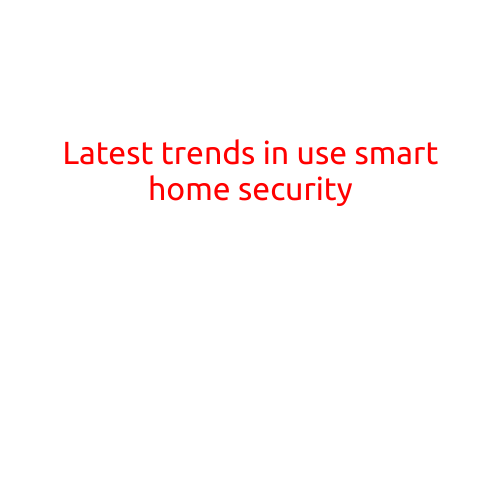
Latest Trends in Use of Smart Home Security
The concept of smart home security has evolved significantly over the years, with advancements in technology and increasing concerns about home safety. As consumers become more aware of the importance of securing their homes, smart home security systems have become a must-have for many. In this article, we’ll explore the latest trends in the use of smart home security and what you should know to stay ahead of the curve.
1. Integration with Other Smart Devices
One of the most significant trends in smart home security is integration with other smart devices. Gone are the days of stand-alone security systems. Today, smart home security systems integrate seamlessly with other devices, such as thermostats, lights, and cameras, to create a comprehensive and cohesive security setup. This integration enables homeowners to control and monitor their security system remotely, receive notifications if something is amiss, and automate their home’s lighting and temperature settings.
2. Artificial Intelligence (AI) and Machine Learning (ML)
Artificial intelligence and machine learning are revolutionizing the smart home security industry. AI-powered security systems can detect and respond to anomalies, such as unusual movement patterns or suspicious sounds, in real-time. This means that you’ll receive alerts and notifications only when it matters most, eliminating false alarms and unnecessary stress.
3. Biometric Authentication
Biometric authentication is becoming increasingly popular in smart home security. With advanced facial recognition, iris scanning, and fingerprint scanning technologies, you can grant or deny access to your home and security system with ease. Biometric authentication provides an added layer of security, making it virtually impossible for unauthorized individuals to gain access to your home.
4. Cloud-Based Storage and Advanced Analytics
Cloud-based storage and advanced analytics are changing the way we approach smart home security. With cloud-based storage, you can store a vast amount of data, including video footage, motion events, and system logs, for easier access and analysis. Advanced analytics enable you to gain valuable insights into your security system’s performance, helping you identify areas for improvement and optimize your system for maximum effectiveness.
5. IoT-Based Devices
The Internet of Things (IoT) has had a significant impact on the smart home security industry. IoT-based devices, such as smart locks, doorbells with cameras, and motion sensors, can be integrated with your security system to create a comprehensive security setup. These devices can also send notifications and alerts if something unusual is detected, keeping you informed and in control.
6. Voice Control
Voice control is becoming increasingly popular in smart home security. With voice assistants like Amazon Alexa and Google Assistant, you can control your security system with simple voice commands. This means you can arm and disarm your system, receive notifications, and adjust settings without lifting a finger.
7. Cybersecurity
Cybersecurity is a critical aspect of smart home security. With the increasing dependence on the internet for home security systems, it’s essential to ensure that your system is secure from cyber threats. Look for security systems with advanced encryption, secure communication protocols, and regular software updates to protect your system from potential vulnerabilities.
8. Mobile Apps and Notifications
Mobile apps and notifications are crucial components of smart home security. With a mobile app, you can control and monitor your security system remotely, receive notifications if something unusual is detected, and stay informed about your system’s performance.
9. Open Standards and Interoperability
Open standards and interoperability are essential for a seamless smart home security experience. Look for security systems that support open standards, allowing you to integrate multiple devices and applications seamlessly.
10. Increased Focus on Energy Efficiency
Finally, smart home security systems are becoming increasingly energy-efficient. Energy-efficient devices and systems not only reduce your carbon footprint but also save you money on energy costs.
In conclusion, the latest trends in smart home security are all about integration, AI, biometric authentication, cloud-based storage, and IoT-based devices. By staying informed about these trends, you can ensure that your smart home security system is optimized for maximum effectiveness, convenience, and energy efficiency. Remember to prioritize cybersecurity, mobile apps, and notifications to stay ahead of the curve and keep your home and family safe.





